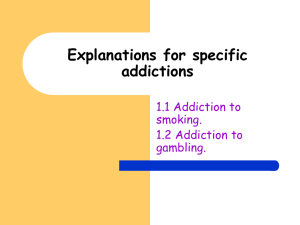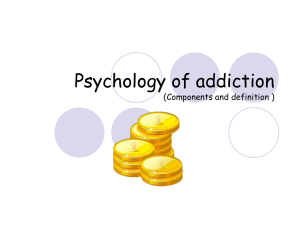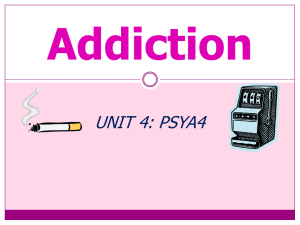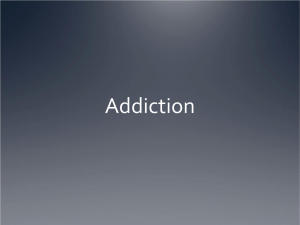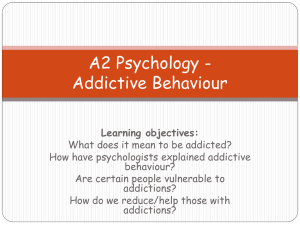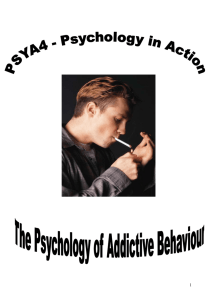addicted
advertisement
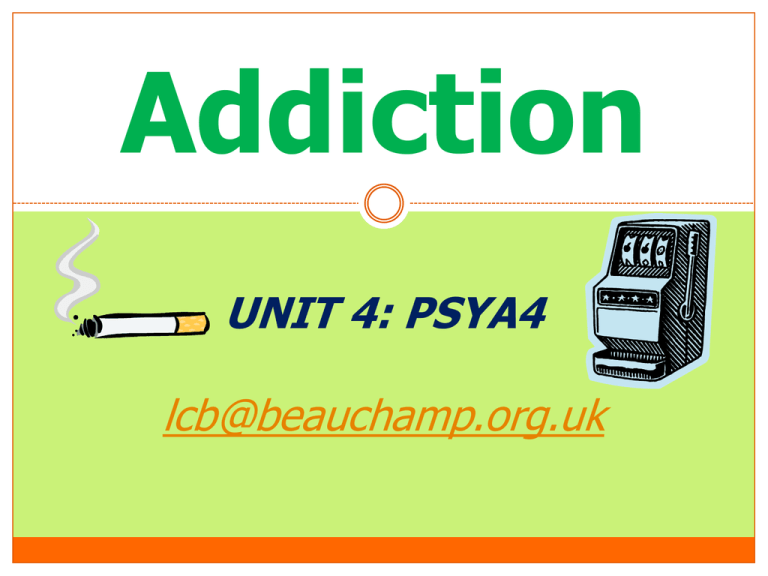
Addiction UNIT 4: PSYA4 lcb@beauchamp.org.uk Content The Psychology of Addictive Behaviour Models of Addictive Behaviour Biological, cognitive and learning approaches to explaining initiation, maintenance and relapse, and their applications to smoking and gambling. Vulnerability to Addiction Risk factors in the development of addiction, including stress, peers, age and personality. Media influences on addictive behaviour. Reducing Addictive Behaviour The theory of planned behaviour as a model for addiction prevention. Types of intervention and their effectiveness, including biological, psychological and public health interventions. Starter Answer the 5 questions in your booklet to review your psychological knowledge of the behaviourist (i.e. learning) model from AS-Level. You have 5 minutes! Basic principles of the learning approach Addictive behaviours are acquired habits which are learned according to the principles of CC, OC and SLT. Addictions can be unlearned. Addictions are not ‘all or nothing’ categories i.e. there are degrees of addictive behaviour. Addictions are no different to any other behaviour. Pair activity Using your psychological knowledge from AS, discuss and make notes in the table in your booklet on… Classical conditioning 2. Operant conditioning 3. Social learning theory (SLT) 1. Where possible, think how it may link to addictive behaviours. Classical conditioning Learning through association. Linking two things together. Conditioning means learned. Stimulus An event which causes a response e.g. food Response A reaction made because the stimulus has been detected e.g. salivation. Pavlov UCS UCR NS CS CR Operant conditioning Learning through reinforcement. Dependent on consequences of actions. Positive reinforcement - pleasant consequence = behaviour repeated. 2. Negative reinforcement – removal of unpleasant consequence = behaviour repeated. 3. Punishment – unpleasant consequence = behaviour not repeated. 1. Social Learning Theory 1. Observation of role models in the environment. 2. Witness reinforcement. 3. Imitate observed behaviour with anticipation of receiving similar reinforcement/reward (vicarious learning). Independent task 1. Complete the table in your booklet (comparing and contrasting biological and learning models of addiction). 2. Colour-code if the term belongs to the biological approach or the learning approach of addictive behaviour. You have 10 minutes. Be prepared to feedback. What’s next? In today’s lesson we are going to look at how the learning approach explains the initiation, maintenance and relapse of smoking addiction. RECAP: What do these terms mean? 1. Initiation? 2. Maintenance? 3. Relapse? Stages in addiction 1. Initiation – the process whereby an individual starts to become addicted. 2. Maintenance – the process whereby people continue to behave addictively even in the face of negative consequences. 3. Relapse – the process whereby individuals who have managed to give up their addictive habits (i.e. they are in remission) start to show signs and symptoms of the addictive behaviour again. Smoking addiction and the learning approach Initiation Independent task Read the information in your booklet on the initiation of smoking addiction according to the learning model and answer the associated questions. You have 10 minutes! – Q&A Maintenance Step 1 UCR = unconditioned response Feel relaxed UCS = unconditioned stimulus Sitting with friends Step 2 NS = neutral stimulus Smoking cigarette + Step 3 CS = conditioned stimulus Smoking cigarette UCS = unconditioned stimulus Sitting with friends UCR = unconditioned response Feel relaxed CR = conditioned response Feel relaxed The individual learned that smoking can provide the same rewards (i.e. feeling relaxed) as the original UCS (i.e. sitting with friends). Relapse Tasks 1) Read the information on the maintenance and relapse of smoking addiction. 2) Summarise this information in your booklet. You have 5 minutes! EVIDENCE – FOR OR AGAINST? Complete the gap fill in your booklet and read the information on Cue-Reactivity Theory. You have 5 minutes – Q&A! EVIDENCE – FOR OR AGAINST? 1. Read the three studies in your booklet. 2. Write conclusions for these studies using the sentence starters to help you. Read the evaluation paragraph and summarise the two main points in the box provided. Exam focus Outline and evaluate the learning approach to explaining the maintenance of smoking behaviour. (4 marks + 6 marks) Prepare an essay plan for the potential exam question above. Evaluation: IDA Gender bias in smoking addiction research The onset and development of smoking follows different patterns in men and women. E.g. research found that women start smoking later than men. Real-world applications Effective forms of smoking prevention programmes should target adolescents (those most vulnerable to influence of peers) to inform them of the social influences. Evaluation: IDA Nature vs. nurture Learning model supports nurture (i.e. role of the environment) but ignores nature (i.e. biological model - genes). Determinism vs. free will Deterministic as it suggests smoking addiction influenced by external factors (environment/learning/social pressure/peers and parents) – however could be argued that they have free will over smoking behaviour as choose who to look to as role model – SLT. To evaluate learning explanations compare to other approaches e.g. biological!!! The Learning Approach to Gambling Addiction Pair task Read the information in the table – the learning explanation for the initiation, maintenance and relapse of gambling addiction. Answer the 8 questions in your booklet. You have 10 minutes. Q&A! Independent task Read the 3 studies in your booklet and complete the sentence explaining why it supports/contradicts the learning explanation of gambling addiction. 10 minutes! Criticisms Can’t explain all forms of gambling – difficult to apply OC principles. E.g. some forms of gambling, short time period between behaviour and consequence (e.g. scratch card), whereas others (e.g. football bet) there is a longer time period between behaviour and outcome. Criticisms Fails to explain why only some people become addicted to gambling. Most people will gamble at some point during their life (e.g. lottery/bingo) and will experience the reinforcement associated with the behaviour. However relatively few become addicts. This suggests that there must be other factors involves in the transition from gambling behaviour to gambling addiction e.g. genetics? Independent tasks 1. 2. 3. 4. 5. Complete the gap fill for ‘determinism.’ Read the paragraph and highlight the key terms. Complete the gap fill for ‘other approaches.’ Fill in the missing sentences for the reductionist argument. Write a paragraph for the nature vs. nurture debate in relation to the learning approach. 15 minutes max! BINGO!!! Choose 6 words from below and put them in your bingo board!!! positive negative punishment classical vicarious financial reinforcement physiological conditioning SLT observation role model social initiation operant imitation association psychological maintenance rewards withdrawal relapse Exam focus Complete the essay plan for the 8-mark past-exam question. 10 minutes using notes. Extension activity Make a mindmap for the learning explanation of smoking and gambling addictions. Next lesson.... Cognitive Approach

